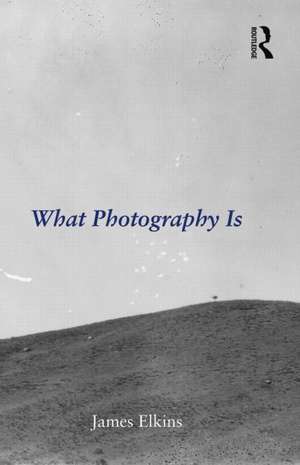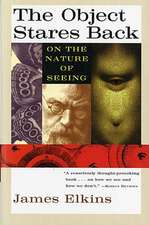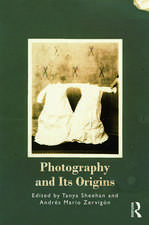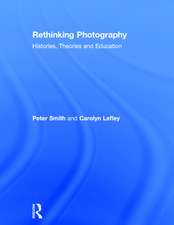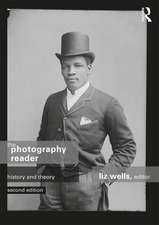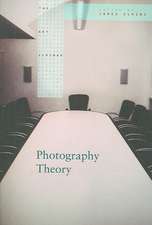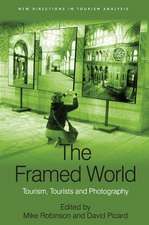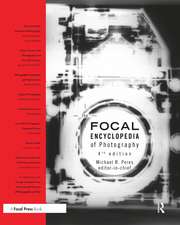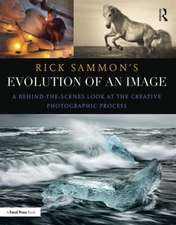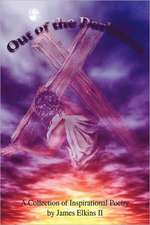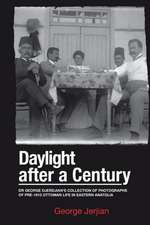What Photography Is
Autor James Elkinsen Limba Engleză Paperback – 26 apr 2011
| Toate formatele și edițiile | Preț | Express |
|---|---|---|
| Paperback (1) | 398.18 lei 6-8 săpt. | |
| Taylor & Francis – 26 apr 2011 | 398.18 lei 6-8 săpt. | |
| Hardback (1) | 1005.39 lei 6-8 săpt. | |
| Taylor & Francis – 26 apr 2011 | 1005.39 lei 6-8 săpt. |
Preț: 398.18 lei
Nou
Puncte Express: 597
Preț estimativ în valută:
76.22€ • 82.82$ • 64.06£
76.22€ • 82.82$ • 64.06£
Carte tipărită la comandă
Livrare economică 21 aprilie-05 mai
Preluare comenzi: 021 569.72.76
Specificații
ISBN-13: 9780415995696
ISBN-10: 0415995698
Pagini: 240
Ilustrații: 67 black & white halftones
Dimensiuni: 138 x 216 x 15 mm
Greutate: 0.66 kg
Ediția:1
Editura: Taylor & Francis
Colecția Routledge
Locul publicării:Oxford, United Kingdom
ISBN-10: 0415995698
Pagini: 240
Ilustrații: 67 black & white halftones
Dimensiuni: 138 x 216 x 15 mm
Greutate: 0.66 kg
Ediția:1
Editura: Taylor & Francis
Colecția Routledge
Locul publicării:Oxford, United Kingdom
Public țintă
Adult education, General, Postgraduate, and UndergraduateCuprins
Preface 1. Writing 2. Selenite, Ice, Salt 3. From the Green River to the Brunswick Peninsula 4. A Drop of Water, World Trade Center Dust 5. The Rapatronic Camera 6. Lingqi
Notă biografică
James Elkins is E.C. Chadbourne Chair in the Department of Art History, Theory, and Criticism at the School of the Art Institute of Chicago. He is the author of Pictures and Tears, How to Use Your Eyes, Stories of Art, Visual Studies, Why Are Our Pictures Puzzles, Our Beautiful, Dry, and Distant Texts, On the Strange Place of Religion in Contemporary Art, and Master Narratives and Their Discontents, all published by Routledge.
He is editor of Art History Versus Aesthetics, Photography Theory, Landscape Theory, The State of Art Criticism, and Visual Literacy, all published by Routledge.
He is editor of Art History Versus Aesthetics, Photography Theory, Landscape Theory, The State of Art Criticism, and Visual Literacy, all published by Routledge.
Recenzii
"The most exciting feature for me of this fascinating book was its articulation of the importance of writing in our engagement with photography. Writing for Elkins means the capacity to elicit articulate intensity in the tracking of the intricate turns and balances that can, and should, take place in a mind responding to expressive non-discursive materials. Here the distinctive feature of photography as a medium is not the punctum or the pursuit of sublimity but the photograph's powers for producing self-reflexive attention to how the work makes us see our own seeing--a power that is at risk when we become proud of the rhetorics that displace what the engagements of distinctive writing can bring to our attention." Charles Altieri, University of California, Berkeley
"In an impassioned dialogue with Roland Barthes, Jim Elkins argues that photography is not 'about' representation and memory—those aspects of the Barthean punctum; rather, photography is 'at war with our attention.' If we focus on its essential materiality and physicality, photography shows us things we would often prefer not to see—the 'splotches and stains, cracks, unpleasant shadows, errant dust' in our natural environment as well as the human pain too hard to look at and yet unavoidably there. What is given by photography is the 'grainy substance of the world' in all its irritating contradictions, its 'displeasures'--the aporias that make the act of seeing itself so difficult. Elkins’s disillusioned meditation on how photography actually works upon the viewer is as original as it is profound." Marjorie Perloff, author of Radical Artifice: Writing Poetry in the Age of Media and Unoriginal Genius: Poetry by Other Means in the 21st Century
"In an impassioned dialogue with Roland Barthes, Jim Elkins argues that photography is not 'about' representation and memory—those aspects of the Barthean punctum; rather, photography is 'at war with our attention.' If we focus on its essential materiality and physicality, photography shows us things we would often prefer not to see—the 'splotches and stains, cracks, unpleasant shadows, errant dust' in our natural environment as well as the human pain too hard to look at and yet unavoidably there. What is given by photography is the 'grainy substance of the world' in all its irritating contradictions, its 'displeasures'--the aporias that make the act of seeing itself so difficult. Elkins’s disillusioned meditation on how photography actually works upon the viewer is as original as it is profound." Marjorie Perloff, author of Radical Artifice: Writing Poetry in the Age of Media and Unoriginal Genius: Poetry by Other Means in the 21st Century
Descriere
In What Photography Is, James Elkins examines the strange and alluring power of photography in the same provocative and evocative manner as he explored oil painting in his best-selling What Painting Is. In the course of an extended imaginary dialogue with Roland Barthes's Camera Lucida, Elkins argues that photography is also about meaninglessness--its apparently endless capacity to show us things that we do not want or need to see--and also about pain, because extremely powerful images can sear permanently into our consciousness. Extensively illustrated with a surprising range of images, the book demonstrates that what makes photography uniquely powerful is its ability to express the difficulty--physical, psychological, emotional, and aesthetic--of the act of seeing.
